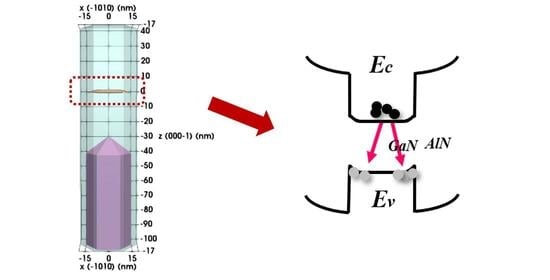Studies on Carrier Recombination in GaN/AlN Quantum Dots in Nanowires with a Core–Shell Structure
Abstract
1. Introduction
2. Materials and Methods
2.1. Preparation of GaN/AlN Quantum Dots in Nanowires
2.2. Characterizations
3. Results and Discussion
4. Conclusions
Author Contributions
Funding
Conflicts of Interest
References
- Li, S.; Waag, A. GaN based nanorods for solid state lighting. J. Appl. Phys. 2012, 111, 071101. [Google Scholar] [CrossRef]
- Hersee, S.; Fairchild, M.; Rishinaramangalam, A.; Ferdous, M.; Zhang, L.; Varangis, P.; Swartzentruber, B.; Talin, A. GaN nanowire light emitting diodes based on templated and scalable nanowire growth process. Electron. Lett. 2009, 45, 75. [Google Scholar] [CrossRef]
- Duan, X.; Huang, Y.; Agarwal, R.; Lieber, C.M. Single-nanowire electrically driven lasers. Nat. Cell Biol. 2003, 421, 241–245. [Google Scholar] [CrossRef]
- Sánchez-García, A.M.; Calleja, E.; Monroy, E.; Sánchez, F.J.; Calle, F.; Munoz, E.; Beresford, R. The effect of the III/V ratio and substrate temperature on the morphology and properties of GaN- and AlN-layers grown by molecular beam epitaxy on Si(111). J. Cryst. Growth 1998, 183, 23–30. [Google Scholar] [CrossRef]
- Maier, K.; Helwig, A.; Müller, G.; Becker, P.; Hille, P.; Schörmann, J.; Teubert, J.; Eickhoff, M. Detection of oxidising gases using an optochemical sensor system based on GaN/InGaN nanowires. Sens. Actuators B Chem. 2014, 197, 87–94. [Google Scholar] [CrossRef]
- Deshpande, S.; Das, A.; Bhattacharya, P. Blue single photon emission up to 200 K from an InGaN quantum dot in AlGaN nanowire. Appl. Phys. Lett. 2013, 102, 161114. [Google Scholar] [CrossRef]
- Yoshizawa, M.; Kikuchi, A.; Mori, M.; Fujita, N.; Kishino, K. Growth of Self-Organized GaN Nanostructures on Al2O3(0001) Al2O3(0001) by RF-Radical Source Molecular Beam Epitaxy. Jpn. J. Appl. Phys. 1997, 36, L459–L462. [Google Scholar] [CrossRef]
- Yoshizawa, M.; Kikuchi, A.; Fujita, N.; Kushi, K.; Sasamoto, H.; Kishino, K. Self-organization of GaN/Al0.18Ga0.82N multi-layer nano-columns on (0001) Al2O3 by RF molecular beam epitaxy for fabricating GaN quantum disks. J. Cryst. Growth 1998, 189, 138–141. [Google Scholar] [CrossRef]
- Calleja, E.; Sánchez-García, M.A.; Sánchez, F.J.; Calle, F.; Naranjo, F.B.; Muñoz, E.; Molina, S.I.; Sanchez, A.M.; Pacheco, F.J.; García, R. Growth of III-nitrides on Si(111) by molecular beam epitaxy Doping, optical, and electrical properties. J. Cryst. Growth 1999, 296–317. [Google Scholar] [CrossRef]
- Bertness, K.; Sanford, N.A.; Davydov, A.V. GaN Nanowires Grown by Molecular Beam Epitaxy. IEEE J. Sel. Top. Quantum Electron. 2011, 17, 847–858. [Google Scholar] [CrossRef]
- Ristic, J.; Rivera, C.; Calleja, E.; Fernández-Garrido, S.; Povoloskyi, M.; Di Carlo, A. Carrier-confinement effects in nanocolumnarGaN∕AlxGa1−xN quantum disks grown by molecular-beam epitaxy. Phys. Rev. B 2005, 72, 085330. [Google Scholar] [CrossRef]
- Guo, W.; Zhang, M.; Bhattacharya, P.; Heo, J. Auger Recombination in III-Nitride Nanowires and Its Effect on Nanowire Light-Emitting Diode Characteristics. Nano Lett. 2011, 11, 1434–1438. [Google Scholar] [CrossRef] [PubMed]
- Wang, Z.; Hao, Z.; Yu, J.D.; Wu, C.; Wang, L.; Wang, J.; Sun, C.Z.; Xiong, B.; Han, Y.J.; Li, H.T.; et al. Manipulating the Band Bending of InGaN/GaN Quantum Dots in Nanowires by Surface Passivation. J. Phys. Chem. C 2017, 121, 6380–6385. [Google Scholar] [CrossRef]
- Calarco, R.; Marso, M.; Richter, T.; Aykanat, A.I.; Meijers, R.; Hart, A.V.; Stoica, T.; Lueth, H. Size-dependent Photoconductivity in MBE-Grown GaN−Nanowires. Nano Lett. 2005, 5, 981–984. [Google Scholar] [CrossRef] [PubMed]
- Lüth, H. Solid Surfaces, Interfaces and Thin Films; Graduate Texts in Physics; Springer International Publishing: Cham, Switzerland, 2015; ISBN 978-3-319-10755-4. [Google Scholar]
- Sun, H.; Shakfa, M.K.; Muhammed, M.M.; Janjua, B.; Li, K.-H.; Lin, R.; Ng, T.K.; Roqan, I.S.; Ooi, B.S.; Li, X. Surface-Passivated AlGaN Nanowires for Enhanced Luminescence of Ultraviolet Light Emitting Diodes. ACS Photon. 2018, 5, 964–970. [Google Scholar] [CrossRef]
- Bermudez, V.M. Study of oxygen chemisorption on the GaN(0001)-(1 × 1) surface. J. Appl. Phys. 1996, 80, 1190–1200. [Google Scholar] [CrossRef]
- Huh, C.; Kim, S.-W.; Kim, H.-S.; Lee, I.-H.; Park, S.-J. Effective sulfur passivation of an n-type GaN surface by an alcohol-based sulfide solution. J. Appl. Phys. 2000, 87, 4591–4593. [Google Scholar] [CrossRef]
- Song, J.-O.; Park, S.-J.; Seong, T.-Y. Effects of sulfur passivation on Ti/Al ohmic contacts to n-type GaN using CH3CSNH2 solution. Appl. Phys. Lett. 2002, 80, 3129–3131. [Google Scholar] [CrossRef]
- Bae, C.; Krug, C.; Mishra, U.; Lucovsky, G.; Chakraborty, A. Surface passivation of n-Ga N by nitrided-thin- Ga2O3/SiO2 and Si3N4 films. J. Appl. Phys. 2004, 96, 2674. [Google Scholar] [CrossRef]
- Hashizume, T.; Ootomo, S.; Hasegawa, H. Suppression of current collapse in insulated gate AlGaN/GaN heterostructure field-effect transistors using ultrathin Al2O3 dielectric. Appl. Phys. Lett. 2003, 83, 2952–2954. [Google Scholar] [CrossRef]
- Nguyen, H.P.T.; Djavid, M.; Woo, S.Y.; Liu, X.; Connie, A.T.; Sadaf, S.; Wang, Q.; Botton, G.A.; Shih, I.; Mi, Z. Engineering the Carrier Dynamics of InGaN Nanowire White Light-Emitting Diodes by Distributed p-AlGaN Electron Blocking Layers. Sci. Rep. 2015, 5, 7744. [Google Scholar] [CrossRef] [PubMed]
- Hetzl, M.; Kraut, M.; Winnerl, J.; Francaviglia, L.; Döblinger, M.; Matich, S.; i Morral, A.F.; Stutzmann, M. Strain-Induced Band Gap Engineering in Selectively Grown GaN–(Al,Ga)N Core–Shell Nanowire Heterostructures. Nano Lett. 2016, 16, 7098–7106. [Google Scholar] [CrossRef] [PubMed]
- Yanxiong, E.; Hao, Z.; Yu, J.; Wu, C.; Liu, R.; Wang, L.; Xiong, B.; Wang, J.; Han, Y.; Sun, C.; et al. MBE Growth of AlN Nanowires on Si Substrates by Aluminizing Nucleation. Nanoscale Res. Lett. 2015, 10, 383. [Google Scholar] [CrossRef][Green Version]
- Yanxiong, E.; Hao, Z.; Yu, J.; Wu, C.; Wang, L.; Xiong, B.; Wang, J.; Han, Y.; Sun, C.; Luo, Y. Studies on the nucleation of MBE grown III-nitride nanowires on Si. Chin. Phys. B 2017, 26, 16103. [Google Scholar] [CrossRef]
- Klein, A.; Säuberlich, F.; Späth, B.; Schulmeyer, T.; Kraft, D. Non-stoichiometry and electronic properties of interfaces. J. Mater. Sci. 2007, 42, 1890–1900. [Google Scholar] [CrossRef]
- Bao, W.; Su, Z.; Zheng, C.; Ning, J.; Xu, S. Carrier Localization Effects in InGaN/GaN Multiple-Quantum-Wells LED Nanowires: Luminescence Quantum Efficiency Improvement and “Negative” Thermal Activation Energy. Sci. Rep. 2016, 6, 34545. [Google Scholar] [CrossRef]
- Simpkins, B.S.; Mastro, M.A.; Eddy, C.R.; Pehrsson, P.E. Surface depletion effects in semiconducting nanowires. J. Appl. Phys. 2008, 103, 104313. [Google Scholar] [CrossRef]
- Fuhrmann, D.; Retzlaff, T.; Rossow, U.; Bremers, H.; Hangleiter, A.; Adé, G.; Hinze, P. Large internal quantum efficiency of In-free UV-emitting GaN∕AlGaN quantum-well structures. Appl. Phys. Lett. 2006, 88, 191108. [Google Scholar] [CrossRef]
- Watanabe, S.; Yamada, N.; Nagashima, M.; Ueki, Y.; Sasaki, C.; Yamada, Y.; Taguchi, T.; Tadatomo, K.; Okagawa, H.; Kudo, H. Internal quantum efficiency of highly-efficient InxGa1−xN-based near-ultraviolet light-emitting diodes. Appl. Phys. Lett. 2003, 83, 4906–4908. [Google Scholar] [CrossRef]
- Gačević, Ž.; Das, A.; Teubert, J.; Kotsar, Y.; Kandaswamy, P.K.; Kehagias, T.; Koukoula, T.; Komninou, P.; Monroy, E. Internal quantum efficiency of III-nitride quantum dot superlattices grown by plasma-assisted molecular-beam epitaxy. J. Appl. Phys. 2011, 109, 103501. [Google Scholar] [CrossRef]
- Himwas, C.; Songmuang, R.; Dang, L.S.; Bleuse, J.; Rapenne, L.; Sarigiannidou, E.; Monroy, E. Thermal stability of the deep ultraviolet emission from AlGaN/AlN Stranski-Krastanov quantum dots. Appl. Phys. Lett. 2012, 101, 241914. [Google Scholar] [CrossRef]
- Kandaswamy, P.K.; Machhadani, H.; Kotsar, Y.; Sakr, S.; Das, A.; Tchernycheva, M.; Rapenne, L.; Sarigiannidou, E.; Julien, F.H.; Monroy, E. Effect of doping on the mid-infrared intersubband absorption in GaN/AlGaN superlattices grown on Si(111) templates. Appl. Phys. Lett. 2010, 96, 141903. [Google Scholar] [CrossRef]
- Ishii, R.; Yoshikawa, A.; Nagase, K.; Funato, M.; Kawakami, Y. 265 nm AlGaN-based deep-ultraviolet light-emitting diodes grown on AlN substrates studied by photoluminescence spectroscopy under ideal pulsed selective and non-selective excitation conditions. Appl. Phys. Express 2020, 13, 102005. [Google Scholar] [CrossRef]
- Johnston, D.C. Stretched exponential relaxation arising from a continuous sum of exponential decays. Phys. Rev. B 2006, 74, 184430. [Google Scholar] [CrossRef]
- Jahangir, S.; Mandl, M.; Strassburg, M.; Bhattacharya, P. Molecular beam epitaxial growth and optical properties of red-emitting (λ = 650 nm) InGaN/GaN disks-in-nanowires on silicon. Appl. Phys. Lett. 2013, 102, 071101. [Google Scholar] [CrossRef]
- Deshpande, S.; Frost, T.; Yan, L.; Jahangir, S.; Hazari, A.; Liu, X.; Mirecki-Millunchick, J.; Mi, Z.; Bhattacharya, P. Formation and Nature of InGaN Quantum Dots in GaN Nanowires. Nano Lett. 2015, 15, 1647–1653. [Google Scholar] [CrossRef] [PubMed]
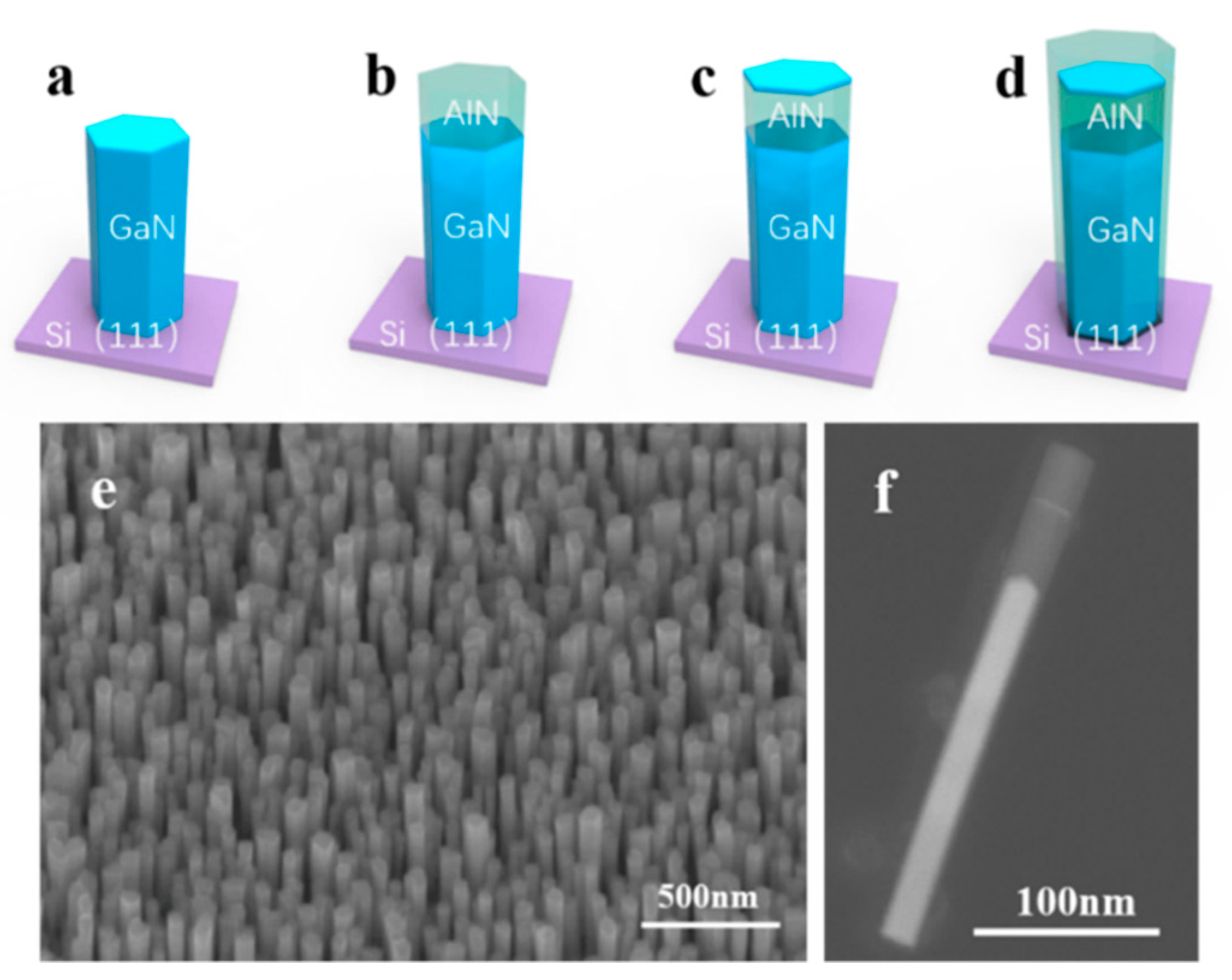
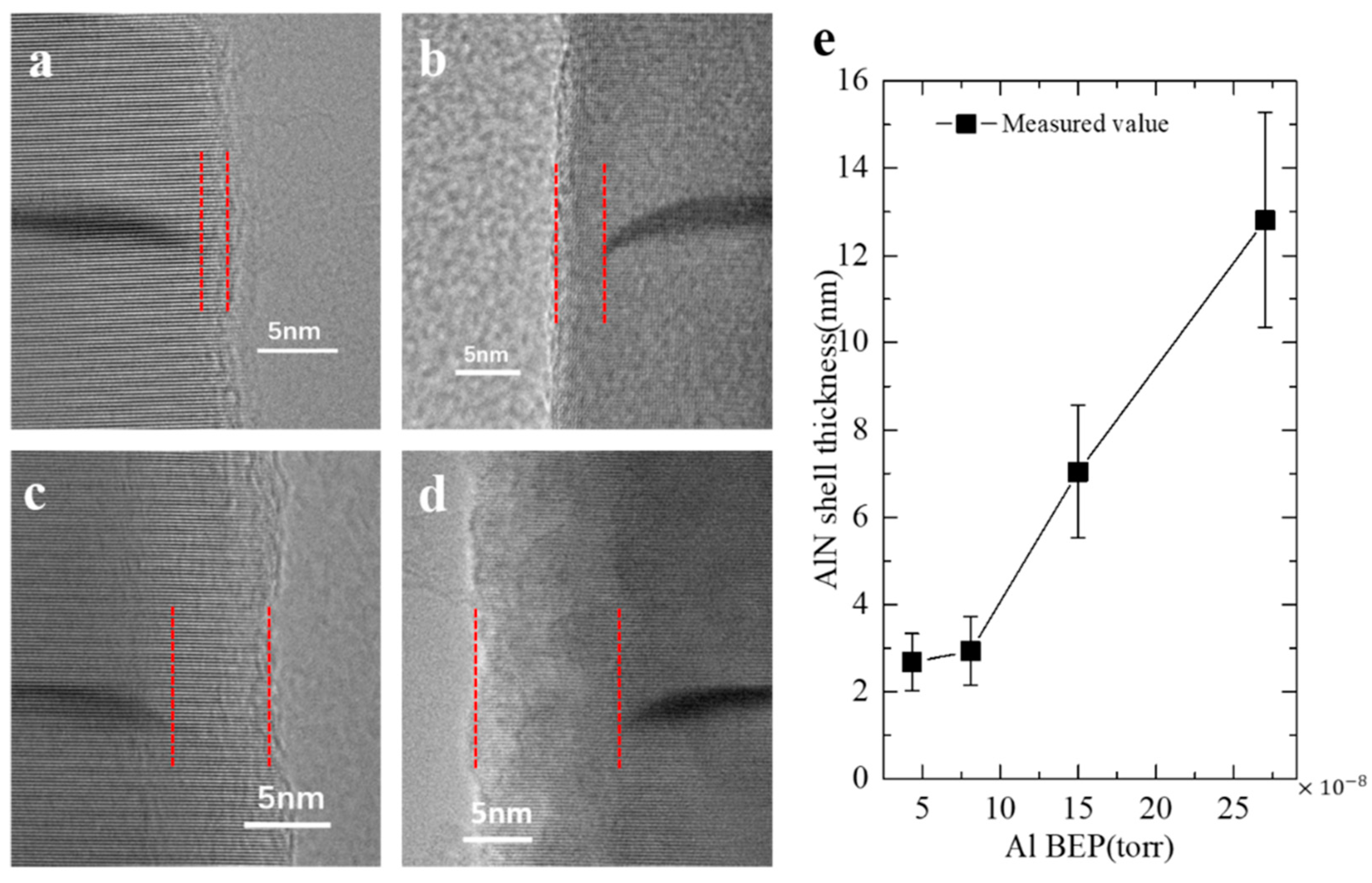
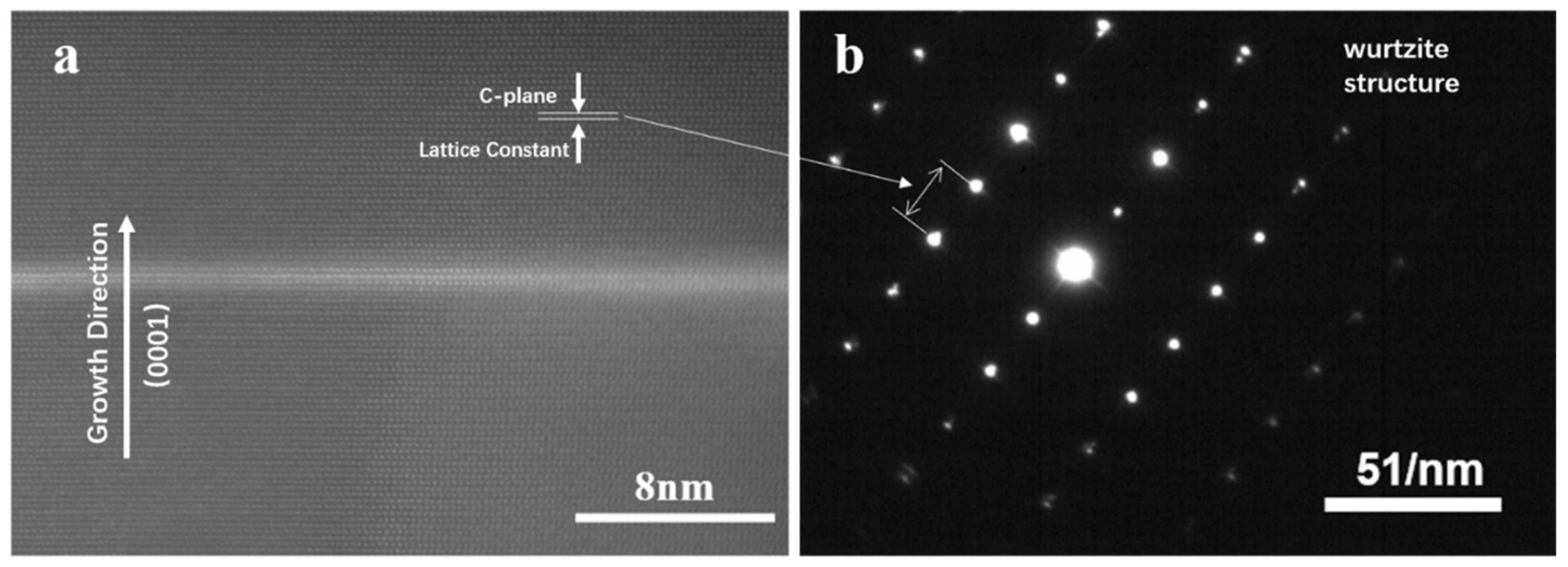
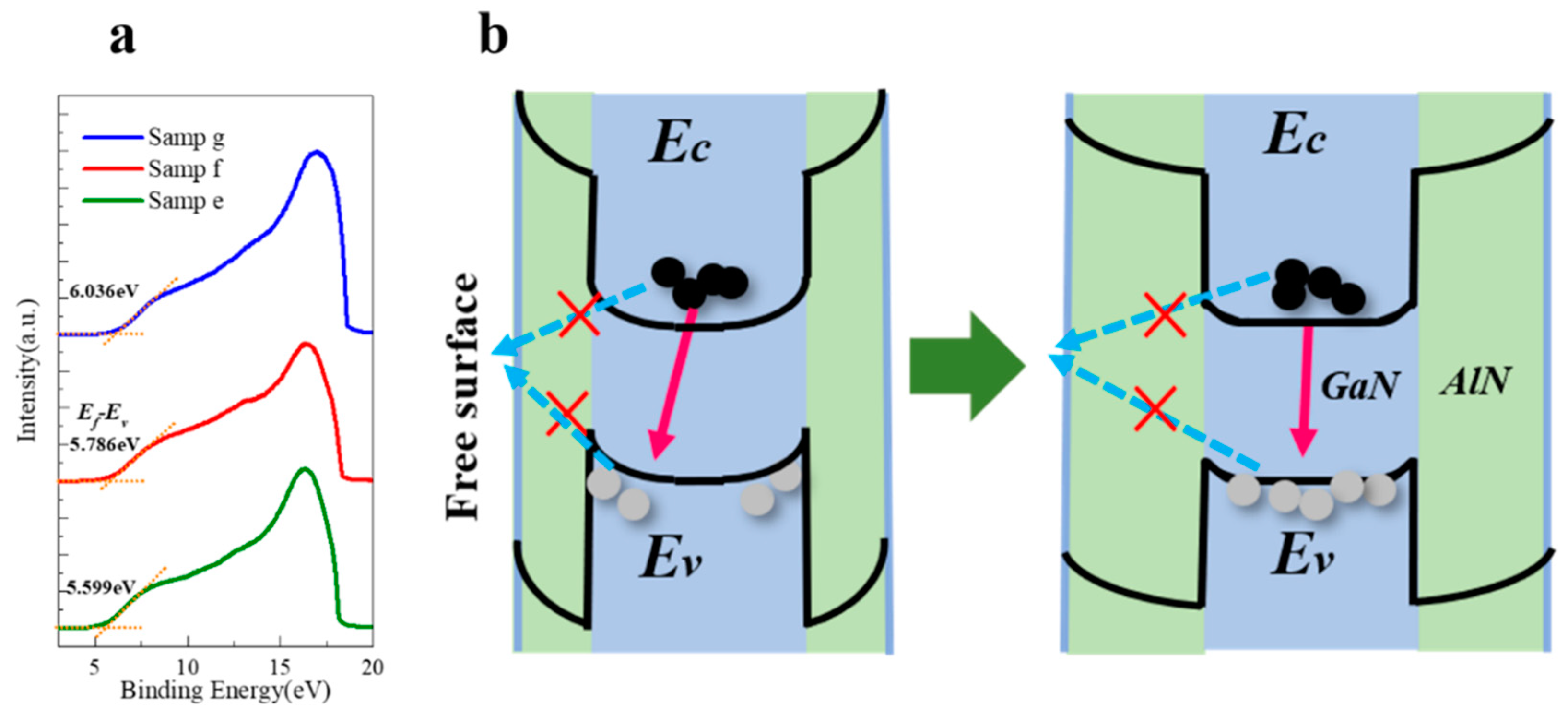
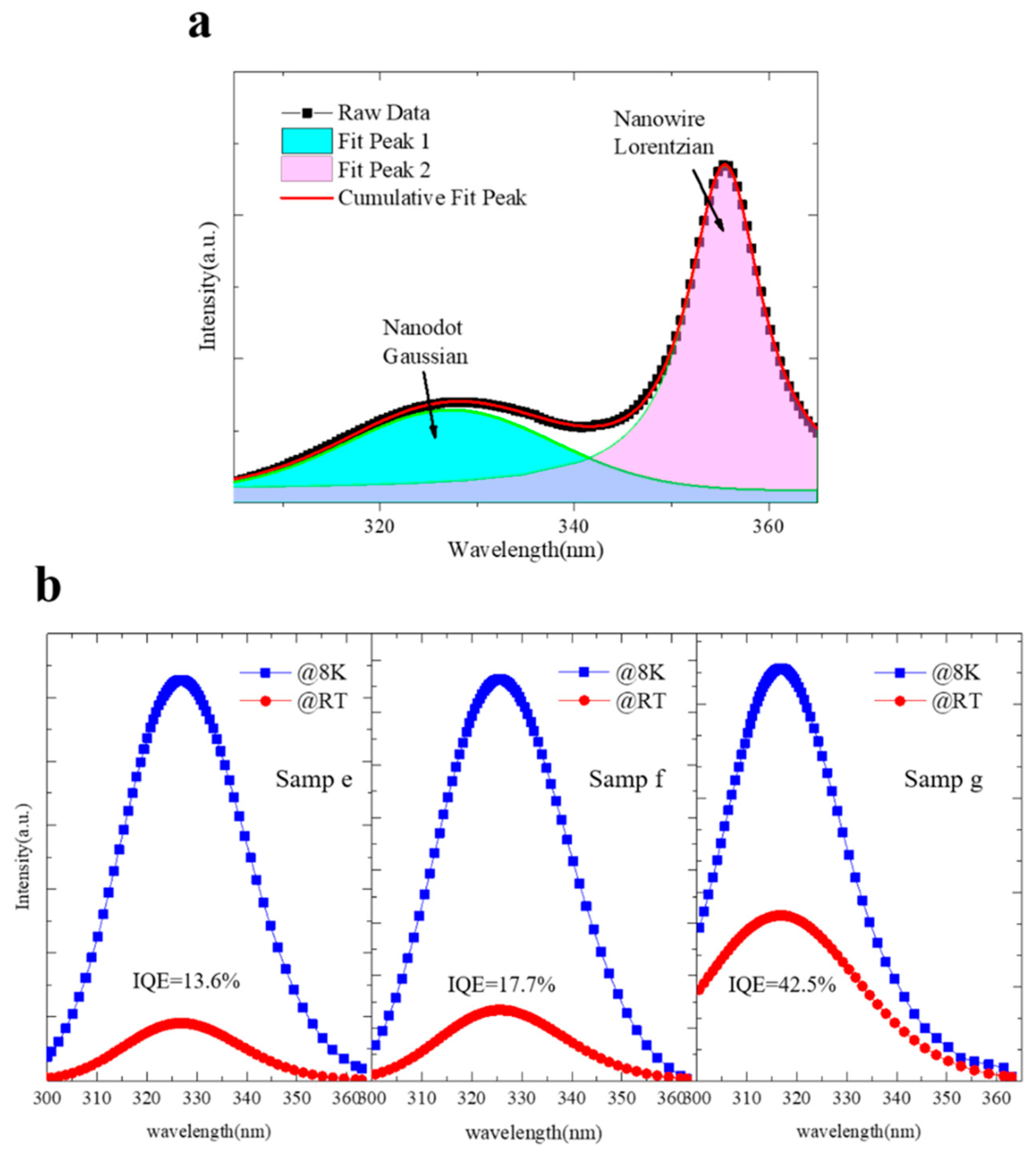
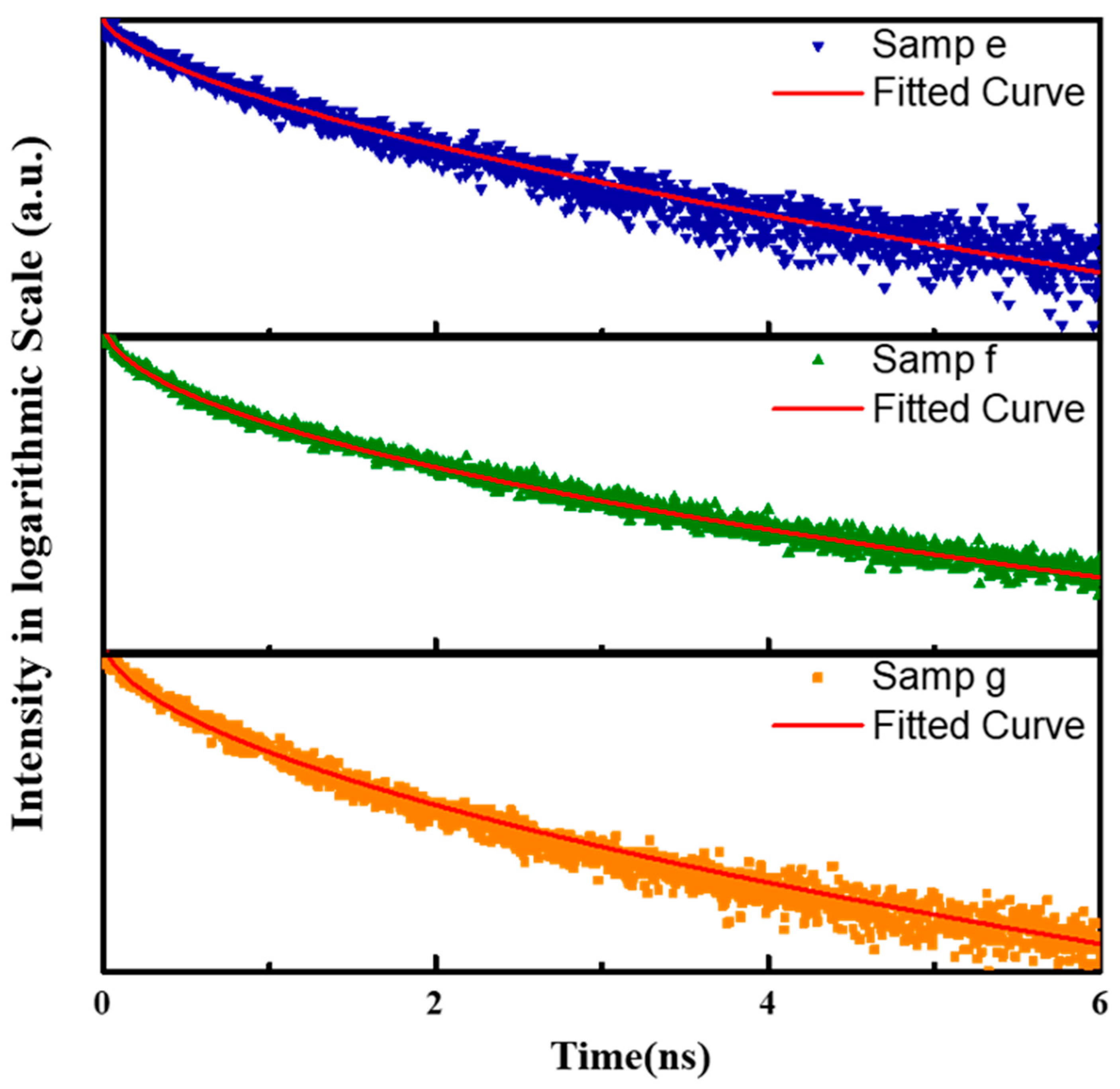
| Sample | Al BEP (Torr) | GaN Dot Growth Time (s) | Shell Thickness (nm) |
|---|---|---|---|
| a | 4.35 × 10−8 | 60 | 2.68 |
| b | 8.1 × 10−8 | 60 | 2.93 |
| c | 1.5 × 10−7 | 60 | 7.04 |
| d | 2.7 × 10−7 | 60 | 12.81 |
| e | 8.1 × 10−8 | 30 | 2.93 (estimated) |
| f | 1.02 × 10−7 | 30 | 4.22 (estimated) |
| g | 1.5 × 10−7 | 30 | 7.04 (estimated) |
| Sample | τ (ps) | τnr (ps) | τr (ps) |
|---|---|---|---|
| e | 817 | 946 | 6007 |
| f | 903 | 1097 | 5103 |
| g | 613 | 1066 | 1443 |
Publisher’s Note: MDPI stays neutral with regard to jurisdictional claims in published maps and institutional affiliations. |
© 2020 by the authors. Licensee MDPI, Basel, Switzerland. This article is an open access article distributed under the terms and conditions of the Creative Commons Attribution (CC BY) license (http://creativecommons.org/licenses/by/4.0/).
Share and Cite
Deng, J.; Hao, Z.; Wang, L.; Yu, J.; Wang, J.; Sun, C.; Han, Y.; Xiong, B.; Li, H.; Zhao, W.; et al. Studies on Carrier Recombination in GaN/AlN Quantum Dots in Nanowires with a Core–Shell Structure. Nanomaterials 2020, 10, 2299. https://doi.org/10.3390/nano10112299
Deng J, Hao Z, Wang L, Yu J, Wang J, Sun C, Han Y, Xiong B, Li H, Zhao W, et al. Studies on Carrier Recombination in GaN/AlN Quantum Dots in Nanowires with a Core–Shell Structure. Nanomaterials. 2020; 10(11):2299. https://doi.org/10.3390/nano10112299
Chicago/Turabian StyleDeng, Jun, Zhibiao Hao, Lai Wang, Jiadong Yu, Jian Wang, Changzheng Sun, Yanjun Han, Bing Xiong, Hongtao Li, Wei Zhao, and et al. 2020. "Studies on Carrier Recombination in GaN/AlN Quantum Dots in Nanowires with a Core–Shell Structure" Nanomaterials 10, no. 11: 2299. https://doi.org/10.3390/nano10112299
APA StyleDeng, J., Hao, Z., Wang, L., Yu, J., Wang, J., Sun, C., Han, Y., Xiong, B., Li, H., Zhao, W., Liang, X., Wang, J., & Luo, Y. (2020). Studies on Carrier Recombination in GaN/AlN Quantum Dots in Nanowires with a Core–Shell Structure. Nanomaterials, 10(11), 2299. https://doi.org/10.3390/nano10112299





